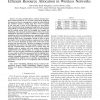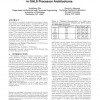TWC
2008
14 years 3 months ago
2008
Abstract-- In many portable devices, wireless network interfaces consume upwards of 30% of scarce system energy. Reducing the transceiver's power consumption to extend the sys...
TPDS
2008
14 years 3 months ago
2008
Recent technological advances have opened up a wide range of distributed real-time applications involving battery-driven embedded devices with local processing and wireless communi...
CORR
2008
Springer
14 years 3 months ago
2008
Springer
We study a sensor node with an energy harvesting source. The generated energy can be stored in a buffer. The sensor node periodically senses a random field and generates a packet....
USENIX
2007
14 years 5 months ago
2007
Current approaches to power management are based on operating systems with full knowledge of and full control over the underlying hardware; the distributed nature of multi-layered...
INFOCOM
2005
IEEE
14 years 8 months ago
2005
IEEE
— In many devices, wireless network interfaces consume upwards of 30% of scarce portable system energy. Extending the system lifetime by minimizing communication power consumptio...
ISLPED
2006
ACM
14 years 9 months ago
2006
ACM
We propose a synergistic temperature and energy management scheme for GALS processors. Localized DVS is applied in domains that contain hotspots, permitting other critical domains...
RTAS
2006
IEEE
14 years 9 months ago
2006
IEEE
Recent studies show that, voltage scaling, which is an efficient energy management technique, has a direct and negative effect on system reliability because of the increased rate...
RTAS
2007
IEEE
14 years 9 months ago
2007
IEEE
The prominent energy management technique in real-time embedded systems, Dynamic Voltage and Frequency Scaling (DVFS), was recently shown to have direct and adverse effects on sys...
IEEEPACT
2008
IEEE
14 years 9 months ago
2008
IEEE
This paper presents an energy management policy for reconfigurable clusters running a multi-tier application, exploiting DVS together with multiple sleep states. We develop a the...
IPSN
2009
Springer
14 years 10 months ago
2009
Springer
As sensor networks mature, there will be an increasing need for re-usable, dynamically taskable software systems that support multiple concurrent applications. In this paper, we c...


